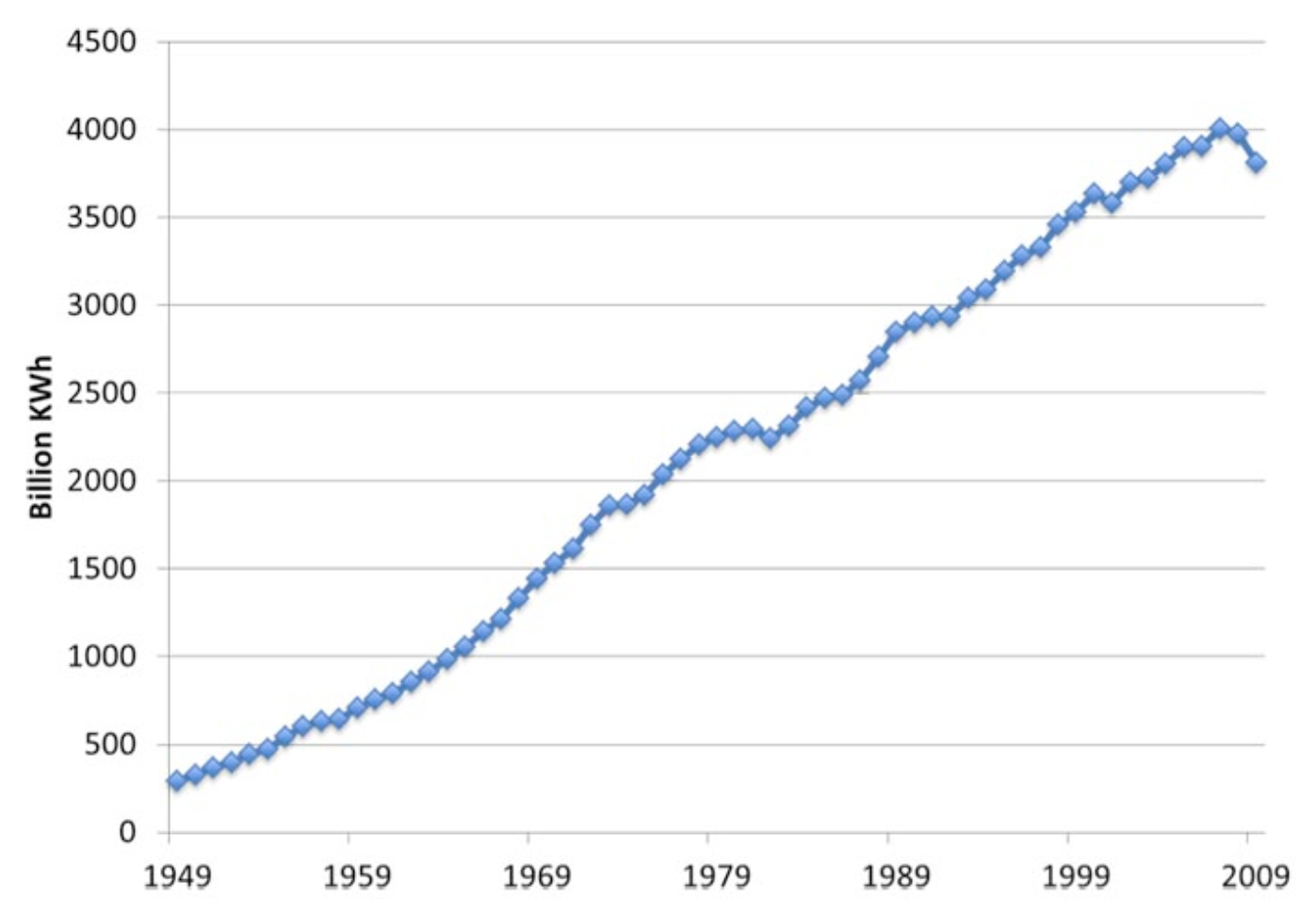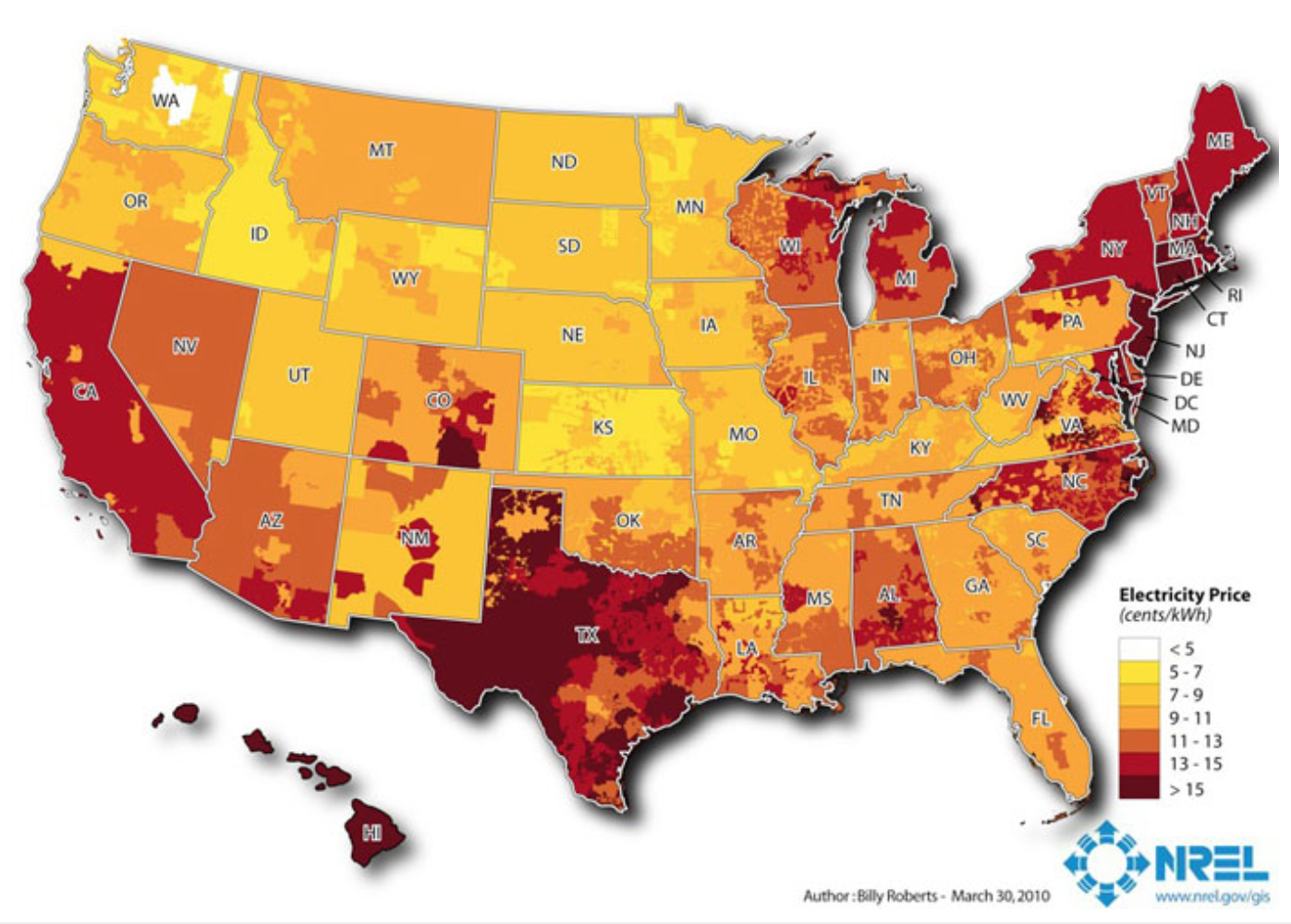5.2: Electricity Demand and Supply in the United States
- Page ID
- 47733
\( \newcommand{\vecs}[1]{\overset { \scriptstyle \rightharpoonup} {\mathbf{#1}} } \)
\( \newcommand{\vecd}[1]{\overset{-\!-\!\rightharpoonup}{\vphantom{a}\smash {#1}}} \)
\( \newcommand{\id}{\mathrm{id}}\) \( \newcommand{\Span}{\mathrm{span}}\)
( \newcommand{\kernel}{\mathrm{null}\,}\) \( \newcommand{\range}{\mathrm{range}\,}\)
\( \newcommand{\RealPart}{\mathrm{Re}}\) \( \newcommand{\ImaginaryPart}{\mathrm{Im}}\)
\( \newcommand{\Argument}{\mathrm{Arg}}\) \( \newcommand{\norm}[1]{\| #1 \|}\)
\( \newcommand{\inner}[2]{\langle #1, #2 \rangle}\)
\( \newcommand{\Span}{\mathrm{span}}\)
\( \newcommand{\id}{\mathrm{id}}\)
\( \newcommand{\Span}{\mathrm{span}}\)
\( \newcommand{\kernel}{\mathrm{null}\,}\)
\( \newcommand{\range}{\mathrm{range}\,}\)
\( \newcommand{\RealPart}{\mathrm{Re}}\)
\( \newcommand{\ImaginaryPart}{\mathrm{Im}}\)
\( \newcommand{\Argument}{\mathrm{Arg}}\)
\( \newcommand{\norm}[1]{\| #1 \|}\)
\( \newcommand{\inner}[2]{\langle #1, #2 \rangle}\)
\( \newcommand{\Span}{\mathrm{span}}\) \( \newcommand{\AA}{\unicode[.8,0]{x212B}}\)
\( \newcommand{\vectorA}[1]{\vec{#1}} % arrow\)
\( \newcommand{\vectorAt}[1]{\vec{\text{#1}}} % arrow\)
\( \newcommand{\vectorB}[1]{\overset { \scriptstyle \rightharpoonup} {\mathbf{#1}} } \)
\( \newcommand{\vectorC}[1]{\textbf{#1}} \)
\( \newcommand{\vectorD}[1]{\overrightarrow{#1}} \)
\( \newcommand{\vectorDt}[1]{\overrightarrow{\text{#1}}} \)
\( \newcommand{\vectE}[1]{\overset{-\!-\!\rightharpoonup}{\vphantom{a}\smash{\mathbf {#1}}}} \)
\( \newcommand{\vecs}[1]{\overset { \scriptstyle \rightharpoonup} {\mathbf{#1}} } \)
\( \newcommand{\vecd}[1]{\overset{-\!-\!\rightharpoonup}{\vphantom{a}\smash {#1}}} \)
\(\newcommand{\avec}{\mathbf a}\) \(\newcommand{\bvec}{\mathbf b}\) \(\newcommand{\cvec}{\mathbf c}\) \(\newcommand{\dvec}{\mathbf d}\) \(\newcommand{\dtil}{\widetilde{\mathbf d}}\) \(\newcommand{\evec}{\mathbf e}\) \(\newcommand{\fvec}{\mathbf f}\) \(\newcommand{\nvec}{\mathbf n}\) \(\newcommand{\pvec}{\mathbf p}\) \(\newcommand{\qvec}{\mathbf q}\) \(\newcommand{\svec}{\mathbf s}\) \(\newcommand{\tvec}{\mathbf t}\) \(\newcommand{\uvec}{\mathbf u}\) \(\newcommand{\vvec}{\mathbf v}\) \(\newcommand{\wvec}{\mathbf w}\) \(\newcommand{\xvec}{\mathbf x}\) \(\newcommand{\yvec}{\mathbf y}\) \(\newcommand{\zvec}{\mathbf z}\) \(\newcommand{\rvec}{\mathbf r}\) \(\newcommand{\mvec}{\mathbf m}\) \(\newcommand{\zerovec}{\mathbf 0}\) \(\newcommand{\onevec}{\mathbf 1}\) \(\newcommand{\real}{\mathbb R}\) \(\newcommand{\twovec}[2]{\left[\begin{array}{r}#1 \\ #2 \end{array}\right]}\) \(\newcommand{\ctwovec}[2]{\left[\begin{array}{c}#1 \\ #2 \end{array}\right]}\) \(\newcommand{\threevec}[3]{\left[\begin{array}{r}#1 \\ #2 \\ #3 \end{array}\right]}\) \(\newcommand{\cthreevec}[3]{\left[\begin{array}{c}#1 \\ #2 \\ #3 \end{array}\right]}\) \(\newcommand{\fourvec}[4]{\left[\begin{array}{r}#1 \\ #2 \\ #3 \\ #4 \end{array}\right]}\) \(\newcommand{\cfourvec}[4]{\left[\begin{array}{c}#1 \\ #2 \\ #3 \\ #4 \end{array}\right]}\) \(\newcommand{\fivevec}[5]{\left[\begin{array}{r}#1 \\ #2 \\ #3 \\ #4 \\ #5 \\ \end{array}\right]}\) \(\newcommand{\cfivevec}[5]{\left[\begin{array}{c}#1 \\ #2 \\ #3 \\ #4 \\ #5 \\ \end{array}\right]}\) \(\newcommand{\mattwo}[4]{\left[\begin{array}{rr}#1 \amp #2 \\ #3 \amp #4 \\ \end{array}\right]}\) \(\newcommand{\laspan}[1]{\text{Span}\{#1\}}\) \(\newcommand{\bcal}{\cal B}\) \(\newcommand{\ccal}{\cal C}\) \(\newcommand{\scal}{\cal S}\) \(\newcommand{\wcal}{\cal W}\) \(\newcommand{\ecal}{\cal E}\) \(\newcommand{\coords}[2]{\left\{#1\right\}_{#2}}\) \(\newcommand{\gray}[1]{\color{gray}{#1}}\) \(\newcommand{\lgray}[1]{\color{lightgray}{#1}}\) \(\newcommand{\rank}{\operatorname{rank}}\) \(\newcommand{\row}{\text{Row}}\) \(\newcommand{\col}{\text{Col}}\) \(\renewcommand{\row}{\text{Row}}\) \(\newcommand{\nul}{\text{Nul}}\) \(\newcommand{\var}{\text{Var}}\) \(\newcommand{\corr}{\text{corr}}\) \(\newcommand{\len}[1]{\left|#1\right|}\) \(\newcommand{\bbar}{\overline{\bvec}}\) \(\newcommand{\bhat}{\widehat{\bvec}}\) \(\newcommand{\bperp}{\bvec^\perp}\) \(\newcommand{\xhat}{\widehat{\xvec}}\) \(\newcommand{\vhat}{\widehat{\vvec}}\) \(\newcommand{\uhat}{\widehat{\uvec}}\) \(\newcommand{\what}{\widehat{\wvec}}\) \(\newcommand{\Sighat}{\widehat{\Sigma}}\) \(\newcommand{\lt}{<}\) \(\newcommand{\gt}{>}\) \(\newcommand{\amp}{&}\) \(\definecolor{fillinmathshade}{gray}{0.9}\)Electricity Demand and Supply in the United States
The United States consumes a bit less than four trillion kilowatt-hours of electricity each year, with the electric sector as a whole representing more than $350 billion in retail sales (that's a few percentage points of total U.S. gross domestic product). The biggest drivers of electricity demand are population, economic activity, the weather, and daily patterns of human activity. The first two factors affect electricity demand over periods of years or longer (see \(Figure \text { } 5.1\), which shows that electricity demand in the U.S. has basically grown each year except during major recessions). The weather and human activity patterns (e.g., it is warmer in the summer than in the winter, and people tend to move around during the day and sleep at night) influences electricity demand from hour to hour and from day to day.

\(Figure \text { } 5.1\): Electricity demand in the U.S. over time.
Fossil fuels dominate electricity supply in the United States, although there are some regional variations (for example, most electricity in the Pacific Northwest is provided through hydropower; this is true of a number of other countries as well, such as Norway). Until very recently, coal provided more than 50% of all electricity generated in the U.S. But increasing environmental constraints on coal utilization and a decline in natural gas prices have induced a rapid shift since 2010, with coal and natural gas on nearly equal footing in terms of overall electricity supply.
Regional variations in fuel utilization are part of the reason that electricity prices vary widely across the U.S., as shown in \(Figure \text { } 5.2\).

\(Figure \text { } 5.2\): U.S. retail electricity prices as of 2010.
Generating stations vary widely in size, corresponding to their intended use. Most nuclear generators are well over 1,000 MW, and there are many coal and natural-gas power plants of this size. These larger facilities are designed to be operated continuously for long periods of time and are used to meet "base load" demand - demand that needs to be satisfied nearly every hour of the day. Demand spikes or "peaks" are normally supplied using smaller generators, ranging in size from less than 1 MW to around 200 MW, that can be turned on and off with relative ease and speed. Many of these are simple-cycle combustion turbines that run on gas, oil, or coal, but hydroelectric facilities are often used as "peakers." Levels of demand intermediate between baseload and peak (called "swing demand" or "shoulder demand") are met with generators that are several hundred megawatts in size; these units are almost always fossil fuel turbines.
The following two videos explain in more detail the patterns of electricity demand and supply in the United States:
Video: Electricity Demand (2:11)
Video: Different Fuels for Electricity Generation (5:23)
The U.S. power transmission grid is highly integrated with grids in Canada and Mexico, so the "U.S. power grid" is perhaps more appropriately called the "North American Power Grid." The North American grid itself is split into three sub-grids that are referred to as "interconnects." The Eastern Interconnect includes states and provinces east of the Rocky Mountains (more or less); the Western Interconnect includes states and provinces west of the Rocky Mountains; and the Texas Interconnect is limited to most of the state of Texas. While there are some weak connections between the three interconnects, they essentially function separately. The National Public Radio has a very nice website called "Visualizing the U.S. Electric Grid" on which you can look at the existing grid relative to fossil and renewable generation resources and also understand how the grid will have to change to support the development of large-scale renewable energy (primarily wind and solar).


